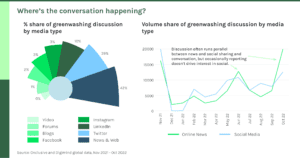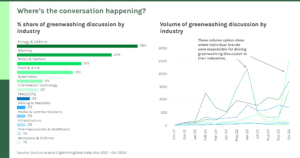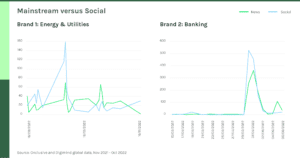In our previous post in this series, we discussed the dramatic rise of greenwashing discussion across the mainstream and social media in recent years. Now we’re going to dig into the details of our media analysis to understand how the greenwashing discussion has evolved. To do this, we analysed related keywords and phrases across mainstream and social media data over a one-year period (Nov 2021 – Oct 2022). Here’s what we found…
Mainstream news doesn’t always drive social media discussion
Greenwashing discussions often run in parallel across online news and social media; the same topics cause similar spikes in volume. But this graph also shows that mainstream news reporting doesn’t always drive the same level of interest on social and in some cases, social discussion isn’t led by mainstream news reporting at all. This tells us that consumers are often driving their own agenda across social media, particularly on Twitter and LinkedIn.
This shows how essential it is to monitor both mainstream and social media discussion about your brand if you want to build an accurate view of your reputation.

Some industries are forced under the spotlight more than others
Industries that featured most prominently in our analysis were banking, retail and fashion, mining and materials, and energy and utilities. The data spikes show where individual companies came under heavy greenwashing scrutiny. But no industry is immune and indeed, over time, we can see that scrutiny across all industries appears to have increased (looking at the upward trend of the graph). A key thought for comms pros in all sectors to be aware of.
It’s interesting to see that although the fashion and retail industry didn’t dominate the discussion in any single month, the slow burn of conversation throughout the year put the industry in second place overall.

Stories about specific brands break first on social media
If we look more closely at the brands that caused discussion spikes in the previous graphs, we can gain even more insight. Our analysis shows that greenwashing discussion about these two brands grew on social media before earning widespread mainstream news coverage. Again, this shows us how informed public audiences are, often breaking greenwashing stories on social media ahead of the mainstream news. There’s still a lot of complexity around the topic, so journalists’ fact checking and carrying out due diligence before publishing a story could cause a slower response. This highlights the need to closely monitor social media discussion about your brand. Because in the case of greenwashing, it could serve as an early warning that a story will break imminently in the mainstream news.

Maybe it’s not always about naming and shaming
Our analysis showed that much of the discussion around greenwashing didn’t name and shame specific companies. This doesn’t mean that businesses and comms teams can breathe easy. Because accusations that do break into the public domain are likely to stand out and be remembered. As audiences become better educated on ESG, regulatory bodies start clamping down on greenwashing offenders, and this information is made publicly available, you could assume that naming-and-shaming is likely to increase.

The emergence of green hushing
Looking at the data, it’s easy to see why companies are choosing to remain quiet about their environmental goals and progress (‘green hushing’). The complexity of the topic, fear of bad publicity, backlash from stakeholders, and potential litigation have all played a role in businesses choosing to stay silent. Some of you might breathe a sigh of relief at the thought of your companies choosing to remain quiet on their climate response or sustainability sitting outside of the comms remit entirely. But this could cause significant reputational damage in the future as your environmental targets and progress are forced under the microscope. You should also consider how your silence could create a competitive advantage for your competitors who choose to be upfront in their communications.
To access the full data analysis and understand how your brand can successfully communicate its environmental sustainability initiatives, download the full whitepaper: Building brand reputation in an era of greenwashing backlash.
In our next post of the series, we’ll share best practices for communicating your green credentials and building a strong brand reputation.
In collaboration with Digimind.
